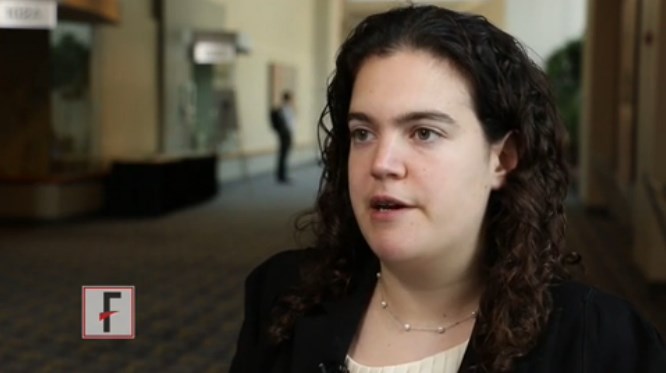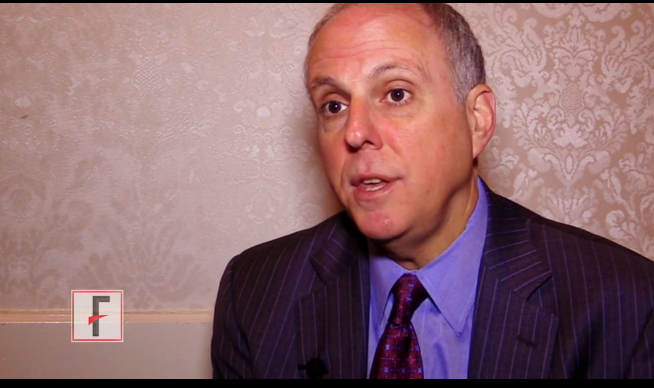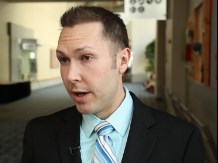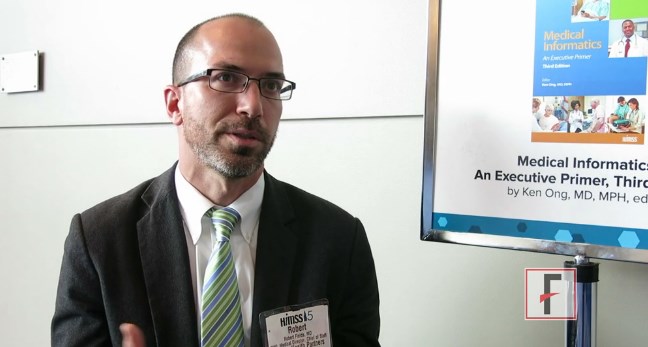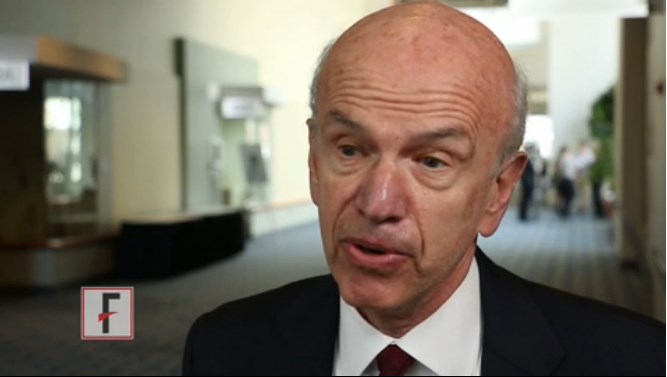User login
VIDEO: Primary care migraine knowledge needs help
WASHINGTON – The development of new educational and training opportunities to increase primary care physicians’ knowledge in diagnosing and managing migraine should extend from medical school student to on-the-job training for attending physicians, according to Dr. Mia Minen, who presented results of a comprehensive survey of primary care physicians’ knowledge about migraine at the annual meeting of the American Academy of Neurology.
Primary care physicians were unsure about when it is best to perform imaging in migraine patients and what kinds of medications are associated with medication overuse headache, said Dr. Minen of the department of neurology at NYU Langone Medical Center. She suggested that a wide range of physicians, including ob.gyns and emergency physicians, could benefit from better knowledge of migraine.
That position was echoed in an interview with Dr. Peter Goadsby of King’s College London and the University of California, San Francisco, who noted that a bigger headache curriculum in medical school and residencies, as well as more on-the-job education, would help greatly.
The video associated with this article is no longer available on this site. Please view all of our videos on the MDedge YouTube channel
The video associated with this article is no longer available on this site. Please view all of our videos on the MDedge YouTube channel
WASHINGTON – The development of new educational and training opportunities to increase primary care physicians’ knowledge in diagnosing and managing migraine should extend from medical school student to on-the-job training for attending physicians, according to Dr. Mia Minen, who presented results of a comprehensive survey of primary care physicians’ knowledge about migraine at the annual meeting of the American Academy of Neurology.
Primary care physicians were unsure about when it is best to perform imaging in migraine patients and what kinds of medications are associated with medication overuse headache, said Dr. Minen of the department of neurology at NYU Langone Medical Center. She suggested that a wide range of physicians, including ob.gyns and emergency physicians, could benefit from better knowledge of migraine.
That position was echoed in an interview with Dr. Peter Goadsby of King’s College London and the University of California, San Francisco, who noted that a bigger headache curriculum in medical school and residencies, as well as more on-the-job education, would help greatly.
The video associated with this article is no longer available on this site. Please view all of our videos on the MDedge YouTube channel
The video associated with this article is no longer available on this site. Please view all of our videos on the MDedge YouTube channel
WASHINGTON – The development of new educational and training opportunities to increase primary care physicians’ knowledge in diagnosing and managing migraine should extend from medical school student to on-the-job training for attending physicians, according to Dr. Mia Minen, who presented results of a comprehensive survey of primary care physicians’ knowledge about migraine at the annual meeting of the American Academy of Neurology.
Primary care physicians were unsure about when it is best to perform imaging in migraine patients and what kinds of medications are associated with medication overuse headache, said Dr. Minen of the department of neurology at NYU Langone Medical Center. She suggested that a wide range of physicians, including ob.gyns and emergency physicians, could benefit from better knowledge of migraine.
That position was echoed in an interview with Dr. Peter Goadsby of King’s College London and the University of California, San Francisco, who noted that a bigger headache curriculum in medical school and residencies, as well as more on-the-job education, would help greatly.
The video associated with this article is no longer available on this site. Please view all of our videos on the MDedge YouTube channel
The video associated with this article is no longer available on this site. Please view all of our videos on the MDedge YouTube channel
AT THE AAN 2015 ANNUAL MEETING
VIDEO: Leadership, transparency key to hospitalist-hospital alignment
NATIONAL HARBOR, MD.– Taking leadership roles and searching for strategies to improve transparency are top ways that hospitalists can create stronger alignments with hospitals, said Dr. Chi Huang.
He spoke at the Society of Hospital Medicine annual meeting about improving care efficiency through stronger communication among health providers and stakeholders, broader partnerships and better delegation of duties. Dr. Huang is hospital medicine department chair and associate chief medical officer for Lahey Hospital & Medical Center in Burlington, Mass.
In a video interview, Dr. Huang discussed the importance of good leadership and how to encourage more transparent hospital environments. He also shared how Lahey was able to reduce overutilization of some services through innovative approaches.
The video associated with this article is no longer available on this site. Please view all of our videos on the MDedge YouTube channel
On Twitter @legal_med
NATIONAL HARBOR, MD.– Taking leadership roles and searching for strategies to improve transparency are top ways that hospitalists can create stronger alignments with hospitals, said Dr. Chi Huang.
He spoke at the Society of Hospital Medicine annual meeting about improving care efficiency through stronger communication among health providers and stakeholders, broader partnerships and better delegation of duties. Dr. Huang is hospital medicine department chair and associate chief medical officer for Lahey Hospital & Medical Center in Burlington, Mass.
In a video interview, Dr. Huang discussed the importance of good leadership and how to encourage more transparent hospital environments. He also shared how Lahey was able to reduce overutilization of some services through innovative approaches.
The video associated with this article is no longer available on this site. Please view all of our videos on the MDedge YouTube channel
On Twitter @legal_med
NATIONAL HARBOR, MD.– Taking leadership roles and searching for strategies to improve transparency are top ways that hospitalists can create stronger alignments with hospitals, said Dr. Chi Huang.
He spoke at the Society of Hospital Medicine annual meeting about improving care efficiency through stronger communication among health providers and stakeholders, broader partnerships and better delegation of duties. Dr. Huang is hospital medicine department chair and associate chief medical officer for Lahey Hospital & Medical Center in Burlington, Mass.
In a video interview, Dr. Huang discussed the importance of good leadership and how to encourage more transparent hospital environments. He also shared how Lahey was able to reduce overutilization of some services through innovative approaches.
The video associated with this article is no longer available on this site. Please view all of our videos on the MDedge YouTube channel
On Twitter @legal_med
AT HOSPITAL MEDICINE 15
VIDEO: Smoking cessation efforts often enhanced by depression treatment
CHICAGO– Helping patients quit smoking, whether those with severe mental illness or comorbid depression, is an “excellent opportunity” for primary care doctors and psychiatrists to work together.
That’s according to Dr. Robert M. Anthenelli, a professor of psychiatry at the University of California, San Diego, and director of the Pacific Treatment and Research Center there.
Depression and smoking are often comorbid in patients, and nearly half of all tobacco products consumed in the United States are done so by people with some form of a psychiatric or other substance use disorder. In this interview, recorded at the meeting, sponsored by Current Psychiatry and American Academy of Clinical Psychiatrists, Dr. Anthenelli discusses brain changes in tobacco use, why there is a link between smoking and mental illness, and what primary care physicians can do to help their patients who smoke. He also addresses whether complete cessation is essential to one’s well-being.
Dr. Anthenelli is a consultant to Pfizer and Arena Pharmaceuticals.
Current Psychiatry and this news organization are owned by the same parent company.
The video associated with this article is no longer available on this site. Please view all of our videos on the MDedge YouTube channel
On Twitter @whitneymcknight
CHICAGO– Helping patients quit smoking, whether those with severe mental illness or comorbid depression, is an “excellent opportunity” for primary care doctors and psychiatrists to work together.
That’s according to Dr. Robert M. Anthenelli, a professor of psychiatry at the University of California, San Diego, and director of the Pacific Treatment and Research Center there.
Depression and smoking are often comorbid in patients, and nearly half of all tobacco products consumed in the United States are done so by people with some form of a psychiatric or other substance use disorder. In this interview, recorded at the meeting, sponsored by Current Psychiatry and American Academy of Clinical Psychiatrists, Dr. Anthenelli discusses brain changes in tobacco use, why there is a link between smoking and mental illness, and what primary care physicians can do to help their patients who smoke. He also addresses whether complete cessation is essential to one’s well-being.
Dr. Anthenelli is a consultant to Pfizer and Arena Pharmaceuticals.
Current Psychiatry and this news organization are owned by the same parent company.
The video associated with this article is no longer available on this site. Please view all of our videos on the MDedge YouTube channel
On Twitter @whitneymcknight
CHICAGO– Helping patients quit smoking, whether those with severe mental illness or comorbid depression, is an “excellent opportunity” for primary care doctors and psychiatrists to work together.
That’s according to Dr. Robert M. Anthenelli, a professor of psychiatry at the University of California, San Diego, and director of the Pacific Treatment and Research Center there.
Depression and smoking are often comorbid in patients, and nearly half of all tobacco products consumed in the United States are done so by people with some form of a psychiatric or other substance use disorder. In this interview, recorded at the meeting, sponsored by Current Psychiatry and American Academy of Clinical Psychiatrists, Dr. Anthenelli discusses brain changes in tobacco use, why there is a link between smoking and mental illness, and what primary care physicians can do to help their patients who smoke. He also addresses whether complete cessation is essential to one’s well-being.
Dr. Anthenelli is a consultant to Pfizer and Arena Pharmaceuticals.
Current Psychiatry and this news organization are owned by the same parent company.
The video associated with this article is no longer available on this site. Please view all of our videos on the MDedge YouTube channel
On Twitter @whitneymcknight
EXPERT ANALYSIS FROM PSYCHIATRY UPDATE 2015
VIDEO: Don’t forget folate for women on antiepilepsy drugs
WASHINGTON – Only 20% of women of childbearing age taking antiepileptic drugs also received a folate prescription, a small study revealed – but a brief intervention helped boost the rate above 60%.
Folic acid supplementation is de rigueur for women of childbearing age – and especially important in very early pregnancy. The need appears even greater in women who take antiepileptic drugs, many of which increase the risk of birth defects.
Despite current recommendations for folic acid supplementation in all women, prescription by neurologists seems low, according to Dr. Brian D. Moseley of the University of Cincinnati.
“We wanted to look at the rates of the prescription of folic acid to women on antiepileptic drugs who were seen in our general neurology clinic,” Dr. Moseley explained.
In an interview at the annual meeting of the American Academy of Neurology, Dr. Moseley discussed the study’s findings, how a brief intervention with the clinic’s physicians increased folic acid prescription rates, and which folic acid dosages may be optimal.
The video associated with this article is no longer available on this site. Please view all of our videos on the MDedge YouTube channel
WASHINGTON – Only 20% of women of childbearing age taking antiepileptic drugs also received a folate prescription, a small study revealed – but a brief intervention helped boost the rate above 60%.
Folic acid supplementation is de rigueur for women of childbearing age – and especially important in very early pregnancy. The need appears even greater in women who take antiepileptic drugs, many of which increase the risk of birth defects.
Despite current recommendations for folic acid supplementation in all women, prescription by neurologists seems low, according to Dr. Brian D. Moseley of the University of Cincinnati.
“We wanted to look at the rates of the prescription of folic acid to women on antiepileptic drugs who were seen in our general neurology clinic,” Dr. Moseley explained.
In an interview at the annual meeting of the American Academy of Neurology, Dr. Moseley discussed the study’s findings, how a brief intervention with the clinic’s physicians increased folic acid prescription rates, and which folic acid dosages may be optimal.
The video associated with this article is no longer available on this site. Please view all of our videos on the MDedge YouTube channel
WASHINGTON – Only 20% of women of childbearing age taking antiepileptic drugs also received a folate prescription, a small study revealed – but a brief intervention helped boost the rate above 60%.
Folic acid supplementation is de rigueur for women of childbearing age – and especially important in very early pregnancy. The need appears even greater in women who take antiepileptic drugs, many of which increase the risk of birth defects.
Despite current recommendations for folic acid supplementation in all women, prescription by neurologists seems low, according to Dr. Brian D. Moseley of the University of Cincinnati.
“We wanted to look at the rates of the prescription of folic acid to women on antiepileptic drugs who were seen in our general neurology clinic,” Dr. Moseley explained.
In an interview at the annual meeting of the American Academy of Neurology, Dr. Moseley discussed the study’s findings, how a brief intervention with the clinic’s physicians increased folic acid prescription rates, and which folic acid dosages may be optimal.
The video associated with this article is no longer available on this site. Please view all of our videos on the MDedge YouTube channel
AT THE AAN 2015 ANNUAL MEETING
VIDEO: Building strong ACOs takes physician engagement, collaboration
CHICAGO – In 2013, Mission Health in North Carolina launched Mission Health Partners, a physician-led accountable care organization of independent physicians, hospitals, and other health providers that focuses on reduced costs, more efficient care, and population health.
But the road to developing Mission Health Partners ACO was not without its challenges, said Dr. Robert Fields, Mission Health Partners ACO quality committee chair and quality director for Mission Medical Associates.
To form a strong organization, physician leaders and administrators first had to gain stakeholder buy-in, build a population health infrastructure, and identify physician champions to support the approach, Dr. Fields said during the annual meeting of the Healthcare Information and Management Systems Society.
In a video interview, Dr. Fields discusses how the Mission Health Partners ACO was formed and how leaders overcame obstacles along the way. Dr. Fields also shares guidance for other doctors who are interested in developing such models.
The video associated with this article is no longer available on this site. Please view all of our videos on the MDedge YouTube channel
On Twitter @legal_med
CHICAGO – In 2013, Mission Health in North Carolina launched Mission Health Partners, a physician-led accountable care organization of independent physicians, hospitals, and other health providers that focuses on reduced costs, more efficient care, and population health.
But the road to developing Mission Health Partners ACO was not without its challenges, said Dr. Robert Fields, Mission Health Partners ACO quality committee chair and quality director for Mission Medical Associates.
To form a strong organization, physician leaders and administrators first had to gain stakeholder buy-in, build a population health infrastructure, and identify physician champions to support the approach, Dr. Fields said during the annual meeting of the Healthcare Information and Management Systems Society.
In a video interview, Dr. Fields discusses how the Mission Health Partners ACO was formed and how leaders overcame obstacles along the way. Dr. Fields also shares guidance for other doctors who are interested in developing such models.
The video associated with this article is no longer available on this site. Please view all of our videos on the MDedge YouTube channel
On Twitter @legal_med
CHICAGO – In 2013, Mission Health in North Carolina launched Mission Health Partners, a physician-led accountable care organization of independent physicians, hospitals, and other health providers that focuses on reduced costs, more efficient care, and population health.
But the road to developing Mission Health Partners ACO was not without its challenges, said Dr. Robert Fields, Mission Health Partners ACO quality committee chair and quality director for Mission Medical Associates.
To form a strong organization, physician leaders and administrators first had to gain stakeholder buy-in, build a population health infrastructure, and identify physician champions to support the approach, Dr. Fields said during the annual meeting of the Healthcare Information and Management Systems Society.
In a video interview, Dr. Fields discusses how the Mission Health Partners ACO was formed and how leaders overcame obstacles along the way. Dr. Fields also shares guidance for other doctors who are interested in developing such models.
The video associated with this article is no longer available on this site. Please view all of our videos on the MDedge YouTube channel
On Twitter @legal_med
AT HIMSS15
VIDEO: Expert picks top studies in Alzheimer’s, migraine, and stroke at AAN
WASHINGTON – A promising early Alzheimer’s treatment, a new finding in the brains of migraineurs, and a practice-changing stroke treatment study are the top picks for clinical research being presented at the annual meeting of the American Academy of Neurology, according to Dr. Natalia Rost, vice chair of the AAN Science Committee.
The first is an early-phase clinical study evaluating a new monoclonal antibody in 166 people with prodromal or mild Alzheimer’s disease. The second study evaluated the association between pain threshold and cortical thickness in patients with migraines. The third is a presentation of the MR CLEAN study results from the Netherlands, which compared standard of care versus standard of care plus mechanical embolectomy in 500 patients with acute stroke – a study that Dr. Rost, a stroke neurologist, described in this video interview as “game-changing.” Dr. Rost is associate professor of neurology at Harvard Medical School and associate director of acute stroke services at Massachusetts General Hospital, both in Boston.
The video associated with this article is no longer available on this site. Please view all of our videos on the MDedge YouTube channel
WASHINGTON – A promising early Alzheimer’s treatment, a new finding in the brains of migraineurs, and a practice-changing stroke treatment study are the top picks for clinical research being presented at the annual meeting of the American Academy of Neurology, according to Dr. Natalia Rost, vice chair of the AAN Science Committee.
The first is an early-phase clinical study evaluating a new monoclonal antibody in 166 people with prodromal or mild Alzheimer’s disease. The second study evaluated the association between pain threshold and cortical thickness in patients with migraines. The third is a presentation of the MR CLEAN study results from the Netherlands, which compared standard of care versus standard of care plus mechanical embolectomy in 500 patients with acute stroke – a study that Dr. Rost, a stroke neurologist, described in this video interview as “game-changing.” Dr. Rost is associate professor of neurology at Harvard Medical School and associate director of acute stroke services at Massachusetts General Hospital, both in Boston.
The video associated with this article is no longer available on this site. Please view all of our videos on the MDedge YouTube channel
WASHINGTON – A promising early Alzheimer’s treatment, a new finding in the brains of migraineurs, and a practice-changing stroke treatment study are the top picks for clinical research being presented at the annual meeting of the American Academy of Neurology, according to Dr. Natalia Rost, vice chair of the AAN Science Committee.
The first is an early-phase clinical study evaluating a new monoclonal antibody in 166 people with prodromal or mild Alzheimer’s disease. The second study evaluated the association between pain threshold and cortical thickness in patients with migraines. The third is a presentation of the MR CLEAN study results from the Netherlands, which compared standard of care versus standard of care plus mechanical embolectomy in 500 patients with acute stroke – a study that Dr. Rost, a stroke neurologist, described in this video interview as “game-changing.” Dr. Rost is associate professor of neurology at Harvard Medical School and associate director of acute stroke services at Massachusetts General Hospital, both in Boston.
The video associated with this article is no longer available on this site. Please view all of our videos on the MDedge YouTube channel
AT THE AAN 2015 ANNUAL MEETING
VIDEO: Clinicians give perspectives on first unprovoked seizure guideline
WASHINGTON – Adult patients and their doctors should decide together whether to treat a first unprovoked seizure, according to a new recommendation issued by the American Academy of Neurology and the American Epilepsy Society. But although treatment reduces the risk of a recurrent seizure by 35%, it doesn’t appear to change the eventual prognosis – and balancing the risks of seizure and the risks of antiepileptic drugs is not easy.
In video interviews at the annual meeting of the American Academy of Neurology, Dr. Allan Krumholz of the University of Maryland, Baltimore, who headed the guideline writing committee, reviews the data, while Dr. Jacqueline French, professor of neurology at New York University puts it in clinical perspective.
But will the recommendations change practice? Dr. Derek Chong, a practicing neurologist at New York University’s Langone Comprehensive Epilepsy Center, shares his own thoughts in a video interview.
The video associated with this article is no longer available on this site. Please view all of our videos on the MDedge YouTube channel
The video associated with this article is no longer available on this site. Please view all of our videos on the MDedge YouTube channel
The video associated with this article is no longer available on this site. Please view all of our videos on the MDedge YouTube channel
On Twitter @alz_gal
WASHINGTON – Adult patients and their doctors should decide together whether to treat a first unprovoked seizure, according to a new recommendation issued by the American Academy of Neurology and the American Epilepsy Society. But although treatment reduces the risk of a recurrent seizure by 35%, it doesn’t appear to change the eventual prognosis – and balancing the risks of seizure and the risks of antiepileptic drugs is not easy.
In video interviews at the annual meeting of the American Academy of Neurology, Dr. Allan Krumholz of the University of Maryland, Baltimore, who headed the guideline writing committee, reviews the data, while Dr. Jacqueline French, professor of neurology at New York University puts it in clinical perspective.
But will the recommendations change practice? Dr. Derek Chong, a practicing neurologist at New York University’s Langone Comprehensive Epilepsy Center, shares his own thoughts in a video interview.
The video associated with this article is no longer available on this site. Please view all of our videos on the MDedge YouTube channel
The video associated with this article is no longer available on this site. Please view all of our videos on the MDedge YouTube channel
The video associated with this article is no longer available on this site. Please view all of our videos on the MDedge YouTube channel
On Twitter @alz_gal
WASHINGTON – Adult patients and their doctors should decide together whether to treat a first unprovoked seizure, according to a new recommendation issued by the American Academy of Neurology and the American Epilepsy Society. But although treatment reduces the risk of a recurrent seizure by 35%, it doesn’t appear to change the eventual prognosis – and balancing the risks of seizure and the risks of antiepileptic drugs is not easy.
In video interviews at the annual meeting of the American Academy of Neurology, Dr. Allan Krumholz of the University of Maryland, Baltimore, who headed the guideline writing committee, reviews the data, while Dr. Jacqueline French, professor of neurology at New York University puts it in clinical perspective.
But will the recommendations change practice? Dr. Derek Chong, a practicing neurologist at New York University’s Langone Comprehensive Epilepsy Center, shares his own thoughts in a video interview.
The video associated with this article is no longer available on this site. Please view all of our videos on the MDedge YouTube channel
The video associated with this article is no longer available on this site. Please view all of our videos on the MDedge YouTube channel
The video associated with this article is no longer available on this site. Please view all of our videos on the MDedge YouTube channel
On Twitter @alz_gal
AT THE AAN 2015 ANNUAL MEETING
VIDEO: New directions in treating adult ADHD
CHICAGO – What are the most important side effects to be aware of when medically treating adult attention-deficit/hyperactivity disorder? What are the most common comorbidities and how should they be treated? And what is the latest in nonpharmaceutical, as well as emerging medical treatment for what Dr. Anthony L. Rostain, a professor of psychiatry at the University of Pennsylvania, Philadelphia, says is not a disease but a disorder?
In this video interview, recorded at Psychiatry Update 2015, sponsored by Current Psychiatry and the American Academy of Clinical Psychiatrists, Dr. Rostain shares what excites him most about emerging treatments for adult ADHD and what clinicians should be most concerned about when prescribing. He also discusses how ADHD overlaps with Tourette syndrome.
Current Psychiatry and this news organization are owned by the same parent company.
The video associated with this article is no longer available on this site. Please view all of our videos on the MDedge YouTube channel
On Twitter @whitneymcknight
CHICAGO – What are the most important side effects to be aware of when medically treating adult attention-deficit/hyperactivity disorder? What are the most common comorbidities and how should they be treated? And what is the latest in nonpharmaceutical, as well as emerging medical treatment for what Dr. Anthony L. Rostain, a professor of psychiatry at the University of Pennsylvania, Philadelphia, says is not a disease but a disorder?
In this video interview, recorded at Psychiatry Update 2015, sponsored by Current Psychiatry and the American Academy of Clinical Psychiatrists, Dr. Rostain shares what excites him most about emerging treatments for adult ADHD and what clinicians should be most concerned about when prescribing. He also discusses how ADHD overlaps with Tourette syndrome.
Current Psychiatry and this news organization are owned by the same parent company.
The video associated with this article is no longer available on this site. Please view all of our videos on the MDedge YouTube channel
On Twitter @whitneymcknight
CHICAGO – What are the most important side effects to be aware of when medically treating adult attention-deficit/hyperactivity disorder? What are the most common comorbidities and how should they be treated? And what is the latest in nonpharmaceutical, as well as emerging medical treatment for what Dr. Anthony L. Rostain, a professor of psychiatry at the University of Pennsylvania, Philadelphia, says is not a disease but a disorder?
In this video interview, recorded at Psychiatry Update 2015, sponsored by Current Psychiatry and the American Academy of Clinical Psychiatrists, Dr. Rostain shares what excites him most about emerging treatments for adult ADHD and what clinicians should be most concerned about when prescribing. He also discusses how ADHD overlaps with Tourette syndrome.
Current Psychiatry and this news organization are owned by the same parent company.
The video associated with this article is no longer available on this site. Please view all of our videos on the MDedge YouTube channel
On Twitter @whitneymcknight
AT PSYCHIATRY UPDATE 2015
VIDEO: Circulating tumor DNA testing shows real-world limits
GENEVA – Circulating tumor DNA currently has one role to play in routine management of lung cancer patients: To check at the time of diagnosis for a treatment-defining mutation in the tumor’s epidermal growth factor receptor gene, but only when the DNA available from the tumor biopsy is inadequate for analysis, Dr. Egbert F. Smith said in a video interview at the European Lung Cancer Congress. That happens for about 10%-25% of newly diagnosed lung-cancer patients, he said.
Dr. Smit, the designated discussant for the Europe-Japan Diagnostic Study for EGFR [epidermal growth factor receptor] Testing (ASSESS) – a study that ran mutational analysis of the EGFR genes in 1,162 patients using circulating tumor (ct) DNA – highlighted the main limitation of this method in the routine-practice setting used by ASSESS: The test’s low sensitivity of 46%.
He attributed this in part to the wide range of methods used to perform the ctDNA analyses in the international study. “Some methods are sensitive, and some are not so sensitive,” said Dr. Smit, professor of pulmonary medicine at VU University Medical Center, Amsterdam.
“You have to think about the limits of your [ctDNA] test, and the analytical sensitivity of the laboratory,” he said. These factors can make a ctDNA test unreliable for ruling out an EGFR mutation. “Do not think that patients do not have an EGFR mutation based only on their plasma circulating DNA,” Dr. Smit advised.
He had no relevant disclosures.
The video associated with this article is no longer available on this site. Please view all of our videos on the MDedge YouTube channel
On Twitter @mitchelzoler
GENEVA – Circulating tumor DNA currently has one role to play in routine management of lung cancer patients: To check at the time of diagnosis for a treatment-defining mutation in the tumor’s epidermal growth factor receptor gene, but only when the DNA available from the tumor biopsy is inadequate for analysis, Dr. Egbert F. Smith said in a video interview at the European Lung Cancer Congress. That happens for about 10%-25% of newly diagnosed lung-cancer patients, he said.
Dr. Smit, the designated discussant for the Europe-Japan Diagnostic Study for EGFR [epidermal growth factor receptor] Testing (ASSESS) – a study that ran mutational analysis of the EGFR genes in 1,162 patients using circulating tumor (ct) DNA – highlighted the main limitation of this method in the routine-practice setting used by ASSESS: The test’s low sensitivity of 46%.
He attributed this in part to the wide range of methods used to perform the ctDNA analyses in the international study. “Some methods are sensitive, and some are not so sensitive,” said Dr. Smit, professor of pulmonary medicine at VU University Medical Center, Amsterdam.
“You have to think about the limits of your [ctDNA] test, and the analytical sensitivity of the laboratory,” he said. These factors can make a ctDNA test unreliable for ruling out an EGFR mutation. “Do not think that patients do not have an EGFR mutation based only on their plasma circulating DNA,” Dr. Smit advised.
He had no relevant disclosures.
The video associated with this article is no longer available on this site. Please view all of our videos on the MDedge YouTube channel
On Twitter @mitchelzoler
GENEVA – Circulating tumor DNA currently has one role to play in routine management of lung cancer patients: To check at the time of diagnosis for a treatment-defining mutation in the tumor’s epidermal growth factor receptor gene, but only when the DNA available from the tumor biopsy is inadequate for analysis, Dr. Egbert F. Smith said in a video interview at the European Lung Cancer Congress. That happens for about 10%-25% of newly diagnosed lung-cancer patients, he said.
Dr. Smit, the designated discussant for the Europe-Japan Diagnostic Study for EGFR [epidermal growth factor receptor] Testing (ASSESS) – a study that ran mutational analysis of the EGFR genes in 1,162 patients using circulating tumor (ct) DNA – highlighted the main limitation of this method in the routine-practice setting used by ASSESS: The test’s low sensitivity of 46%.
He attributed this in part to the wide range of methods used to perform the ctDNA analyses in the international study. “Some methods are sensitive, and some are not so sensitive,” said Dr. Smit, professor of pulmonary medicine at VU University Medical Center, Amsterdam.
“You have to think about the limits of your [ctDNA] test, and the analytical sensitivity of the laboratory,” he said. These factors can make a ctDNA test unreliable for ruling out an EGFR mutation. “Do not think that patients do not have an EGFR mutation based only on their plasma circulating DNA,” Dr. Smit advised.
He had no relevant disclosures.
The video associated with this article is no longer available on this site. Please view all of our videos on the MDedge YouTube channel
On Twitter @mitchelzoler
EXPERT ANALYSIS FROM ELCC 2015
VIDEO: Episode-bundling program generates success, satisfaction in Arkansas
CHICAGO – Bundled care payments are a hot topic among physicians as the Centers for Medicare and Medicaid Services continues to roll out its bundled payment pilot program.
But does the method really improve quality and enhance care delivery?
Physician leaders with the Arkansas Health Care Payment Improvement Initiative may have the answer. Arkansas was the first to implement a statewide payment reform initiative that rewards doctors for quality care and enables them to access data about overall care quality delivered during a set time period.
Dr. William Golden, medical director of the Arkansas Division of Medical Services, Department of Human Services, spoke about the initiative and its impact at the annual meeting of the Healthcare Information and Management Systems Society.
The initiative was launched in 2011 and includes partnerships between the Arkansas Department of Human Services, Arkansas Blue Cross and Blue Shield, and QualChoice of Arkansas.
The program enables physicians to share in the savings or excess costs of an episode, depending on their performance for each episode. For some episodes, health providers submit information through the billing system’s provider portal, a HIPAA-compliant online tool that collects data about overall care and performance. The portal allows hospitals, physicians, and other providers to submit a set of quality metrics data that will to be tied to the initiative’s financial incentives.
The tool also allows doctors designated as principal accountable providers to access reports about their average quality, costs, and utilization for care episodes.
During the payment initiative’s first phase, insurers introduced five episodes of care, including upper respiratory infections, total hip and knee replacements, congestive heart failure, attention deficit/hyperactivity disorder, and perinatal.
In a video interview, Dr. Golden discusses the initiative, the road to build its design, and how the program has affected physicians and patients.
The video associated with this article is no longer available on this site. Please view all of our videos on the MDedge YouTube channel
On Twitter @legal_med
CHICAGO – Bundled care payments are a hot topic among physicians as the Centers for Medicare and Medicaid Services continues to roll out its bundled payment pilot program.
But does the method really improve quality and enhance care delivery?
Physician leaders with the Arkansas Health Care Payment Improvement Initiative may have the answer. Arkansas was the first to implement a statewide payment reform initiative that rewards doctors for quality care and enables them to access data about overall care quality delivered during a set time period.
Dr. William Golden, medical director of the Arkansas Division of Medical Services, Department of Human Services, spoke about the initiative and its impact at the annual meeting of the Healthcare Information and Management Systems Society.
The initiative was launched in 2011 and includes partnerships between the Arkansas Department of Human Services, Arkansas Blue Cross and Blue Shield, and QualChoice of Arkansas.
The program enables physicians to share in the savings or excess costs of an episode, depending on their performance for each episode. For some episodes, health providers submit information through the billing system’s provider portal, a HIPAA-compliant online tool that collects data about overall care and performance. The portal allows hospitals, physicians, and other providers to submit a set of quality metrics data that will to be tied to the initiative’s financial incentives.
The tool also allows doctors designated as principal accountable providers to access reports about their average quality, costs, and utilization for care episodes.
During the payment initiative’s first phase, insurers introduced five episodes of care, including upper respiratory infections, total hip and knee replacements, congestive heart failure, attention deficit/hyperactivity disorder, and perinatal.
In a video interview, Dr. Golden discusses the initiative, the road to build its design, and how the program has affected physicians and patients.
The video associated with this article is no longer available on this site. Please view all of our videos on the MDedge YouTube channel
On Twitter @legal_med
CHICAGO – Bundled care payments are a hot topic among physicians as the Centers for Medicare and Medicaid Services continues to roll out its bundled payment pilot program.
But does the method really improve quality and enhance care delivery?
Physician leaders with the Arkansas Health Care Payment Improvement Initiative may have the answer. Arkansas was the first to implement a statewide payment reform initiative that rewards doctors for quality care and enables them to access data about overall care quality delivered during a set time period.
Dr. William Golden, medical director of the Arkansas Division of Medical Services, Department of Human Services, spoke about the initiative and its impact at the annual meeting of the Healthcare Information and Management Systems Society.
The initiative was launched in 2011 and includes partnerships between the Arkansas Department of Human Services, Arkansas Blue Cross and Blue Shield, and QualChoice of Arkansas.
The program enables physicians to share in the savings or excess costs of an episode, depending on their performance for each episode. For some episodes, health providers submit information through the billing system’s provider portal, a HIPAA-compliant online tool that collects data about overall care and performance. The portal allows hospitals, physicians, and other providers to submit a set of quality metrics data that will to be tied to the initiative’s financial incentives.
The tool also allows doctors designated as principal accountable providers to access reports about their average quality, costs, and utilization for care episodes.
During the payment initiative’s first phase, insurers introduced five episodes of care, including upper respiratory infections, total hip and knee replacements, congestive heart failure, attention deficit/hyperactivity disorder, and perinatal.
In a video interview, Dr. Golden discusses the initiative, the road to build its design, and how the program has affected physicians and patients.
The video associated with this article is no longer available on this site. Please view all of our videos on the MDedge YouTube channel
On Twitter @legal_med
AT HIMSS15
